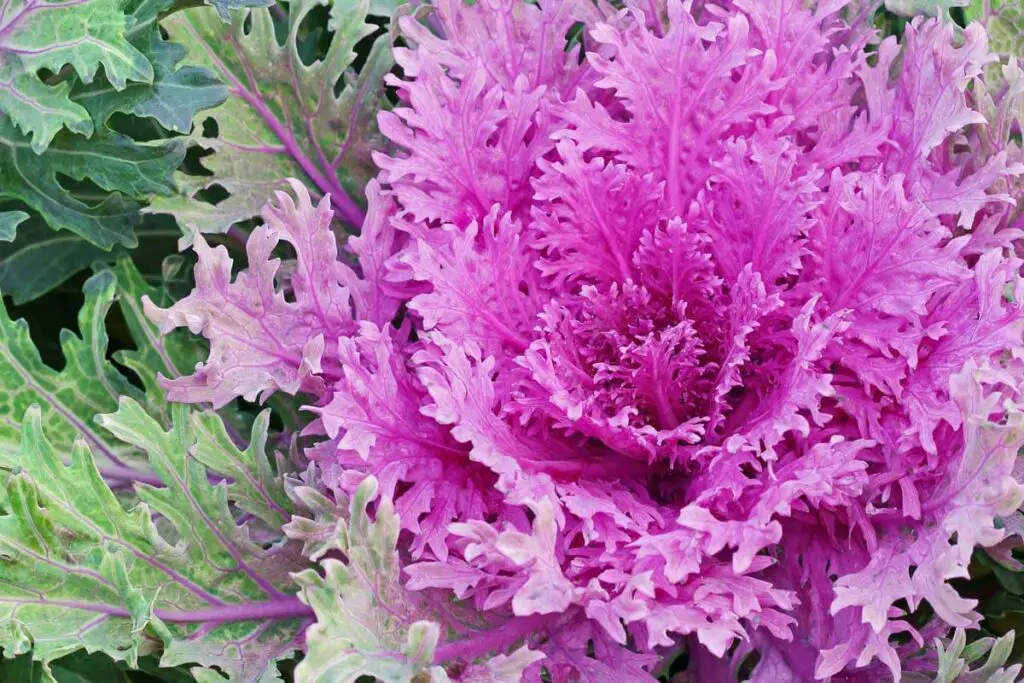Introduction
Welcome to the kale revolution! While kale is widely known for its nutritional value, flowering kale adds a delightful twist with its ornamental appeal. In this article, we’ll delve into the fascinating realm of flowering kale, exploring its cultivation, uses, benefits, and more.
The Splendor of Flowering Kale
Flowering kale, also known as ornamental kale or decorative cabbage, is a stunning addition to any garden or landscape. With its vibrant hues and intricate foliage, it adds a pop of color and texture, especially during the cooler months.
Flowering kale varieties boast a mesmerizing array of colors, including shades of purple, pink, white, and green. The leaves form rosettes that resemble large flowers, hence the name “flowering kale.” Whether planted in beds, borders, or containers, these striking plants never fail to captivate attention.
Cultivating Flowering Kale
Cultivating flowering kale is relatively straightforward, making it an ideal choice for both novice and seasoned gardeners alike. Here are some essential tips for growing healthy and vibrant flowering kale:
- Choose the Right Location: Flowering kale thrives in full sun to partial shade. Select a location with well-drained soil and adequate airflow.
- Planting Time: Plant flowering kale in early fall for a stunning display throughout the cooler months. Alternatively, you can sow seeds indoors in late summer and transplant seedlings outdoors once they’re established.
- Soil Preparation: Amend the soil with compost or organic matter to improve drainage and fertility. Aim for a slightly acidic to neutral pH level.
- Spacing: Space flowering kale plants approximately 12 to 18 inches apart to allow for adequate growth and airflow.
- Watering and Maintenance: Keep the soil consistently moist, especially during dry periods. Mulching around the base of the plants helps retain moisture and suppress weeds. Remove any dead or yellowing leaves to promote healthy growth.
- Pest and Disease Control: While flowering kale is relatively resistant to pests and diseases, keep an eye out for aphids, caterpillars, and fungal issues. Use organic pest control methods when necessary.
Health Benefits of Flowering Kale
Beyond its visual appeal, flowering kale offers a plethora of health benefits. Packed with essential nutrients, it’s a nutritious addition to any diet. Here are some of the key health benefits of incorporating flowering kale into your meals:
- Rich in Antioxidants: Flowering kale is loaded with antioxidants, including vitamin C and beta-carotene, which help combat oxidative stress and inflammation.
- Nutrient Dense: This leafy green is an excellent source of vitamins K, A, and C, as well as minerals like calcium and manganese, essential for bone health and overall well-being.
- Heart-Healthy: Consuming flowering kale may help lower cholesterol levels and reduce the risk of heart disease, thanks to its high fiber and omega-3 fatty acid content.
- Boosts Immunity: The abundance of vitamins and minerals in flowering kale supports a robust immune system, helping the body fend off infections and illnesses.
FAQs (Frequently Asked Questions)
- How do I care for flowering kale during the winter months? Flowering kale is surprisingly cold tolerant and can withstand frosty temperatures. However, if you experience prolonged periods of extreme cold, consider providing additional protection with a layer of mulch or a frost cloth.
- Can I eat flowering kale? While flowering kale is primarily grown for ornamental purposes, it is edible. However, the taste and texture may differ from traditional kale varieties. Young leaves can be used in salads or cooked dishes, but older leaves tend to be tougher and more bitter.
- Is flowering kale suitable for container gardening? Absolutely! Flowering kale is well-suited for container gardening, making it an excellent choice for balconies, patios, or small outdoor spaces. Choose a large container with adequate drainage and follow the same planting and care guidelines as for garden beds.
- How long does flowering kale typically last? Flowering kale is a biennial plant, meaning it completes its life cycle over two years. However, it is often grown as an annual in colder climates, with the foliage typically lasting throughout the fall and winter months.
- Can I propagate flowering kale from seeds? Yes, flowering kale can be propagated from seeds. Sow seeds indoors in late summer, then transplant seedlings outdoors once they’ve developed several true leaves. Alternatively, collect seeds from mature plants and sow them directly in the garden bed or containers.
- Are there any companion plants that pair well with flowering kale? Flowering kale complements a variety of cool-season plants in the garden, including pansies, violas, ornamental grasses, and winter-flowering bulbs like tulips and daffodils.
Conclusion
In conclusion, flowering kale is not only a feast for the eyes but also a nutritional powerhouse with a host of health benefits. Whether you’re looking to add visual interest to your garden or boost your culinary repertoire, flowering kale deserves a prime spot in your outdoor space. Embrace the beauty and bounty of this versatile plant and enjoy its myriad delights throughout the seasons.


